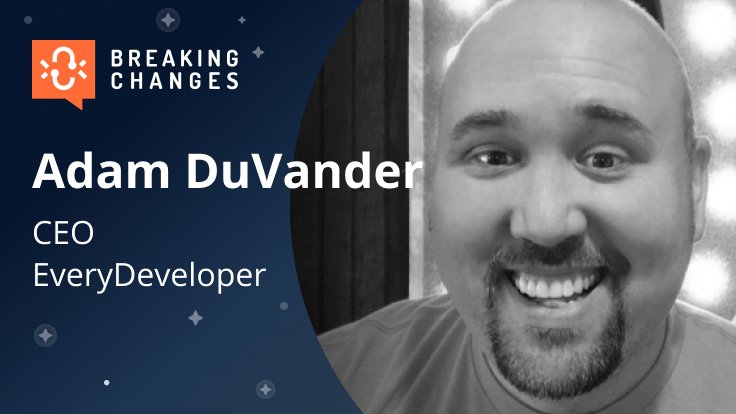“Breaking Changes” Episode 4 Recap: EveryDeveloper’s Adam DuVander
In episode 4 of Breaking Changes—our weekly talk show where Postman Chief Evangelist Kin Lane hosts stellar guests from all across the API universe to discuss, debate, and solve the latest topics around APIs and API-first—EveryDeveloper CEO Adam DuVander shares his expertise. He and Kin discuss some of the common content-related pitfalls in the API world—whether it’s confusing documentation or a boring announcement about a developer tool’s new features—and how to create great content and tell API stories that make an authentic impact. This episode is titled “Storytelling from the Developer Perspective.”
It’s difficult to connect with technical audiences if the messages are coming from someone who doesn’t understand the technology at hand, and that can often raise some flags in the audience’s mind about the authenticity of the product. Adam gives advice on how to create content that genuinely aligns with developers.
You can tune in and subscribe to the Breaking Changes podcast on Spotify, Apple Podcast, Google Podcast, and Amazon music, or watch it on Youtube for more details.
Episode topics
- What content resonates with developers?
- What keeps the developer experience grounded and genuine so that developers relate?
- How can your team scale its content effort?
Episode highlights
What content resonates with developers?
- This is essentially the kind of content that helps developers do their jobs better and spark curiosity and desire to learn. Adam says, “So the classic piece, of course, would be an announcement post, but that announcement post should really be framed around why it even matters and what are the problems that it solves.”
- In addition to having blog posts that dig into specific use cases, Adam talks about creating a sample app built for a use case. He says, “A sample app is really more code than content, though for a sample app to be most useful, I think it has to have a tutorial alongside it, have a code repo that is easy to copy—those sort of things that make it clear what the next step is that a developer could take with it.”
- The discussion further covers different types of content, from long-form guides that take developers through nuances and edge cases to documentation.
What keeps the developer experience grounded and genuine so that developers relate?
- Adam draws on his experience to talk about connecting with developers at a more meaningful level. The key lies in understanding the real problem and aiming to solve it rather than spending a lot of time on a one-time hit content piece.
- Adam says, “In my experience, it’s been much more fulfilling to have written things that get a few hundred developers every month checking it out versus the 10,000 or whatever it is on that one day. That consistent attention and knowing that you’ve solved the problem there and that you start to get people writing in about it and tweeting and really seeing that you’re actually solving a problem there—that’s the stuff that’s hugely fulfilling.”
- Another common problem Adam says he sees is content lacking any point of view. He advises, “Every company is founded with an opinion, and it’s okay to share that opinion.”
How can your team scale its content effort?
- Adam and Kin address another common problem: when companies start to scale content efforts without actually thinking about what needs to be scaled. A strategic approach to content involves identifying relevant content topics to ensure that it covers what developers care about. It really helps to research if people search for a particular topic and how they refer to it when they search.
- Adam talks about the benefits of pairing engineers with editorial teams to create solid content. He says, “If you have [an engineer] who has some of those non-engineer skills that make [writing] a natural fit for them, then that’s great, but a lot of times they don’t. And so they need an editor to pair with them or really a ghostwriter in some cases.” This helps in saving precious engineering time and makes the process sustainable.
- Kin talks about reaching people at a more meaningful level and sees it as part of the feedback loop. Set up feedback loops by reaching out to people; go beyond analytics-tools data to understand what’s sticking against the wall and what’s not. He says, “Hopefully soon we’ll be going out to actual events and meetups again, and you have your finger on that pulse.” Kin highlights another key aspect: community talent. “Use it as a feedback loop to grab stories, but then also look for the talent-acquisition people you can hire or bring on [as] champions or community managers.”
Watch the full episode
Previous episodes:
- “Transforming Business through APIs” with Shutterstock VP/GM of Platform Solutions Alex Reynolds
- “Calibrating Your ‘API Compass’ as Part of Your API Strategy” with LaunchAny Founder and Executive API Consultant James Higginbotham
- “Creating a SaaS Management Platform” with BetterCloud VP of Engineering Lorinda Brandon
Sign up for exclusive content
Kin will be sharing exclusive Breaking Changes content with the show’s subscribers, including hand-picked moments spanning helpful perspectives, industry news, and behind-the-scenes stories. Stay in the know by subscribing here.

What do you think about this topic? Tell us in a comment below.